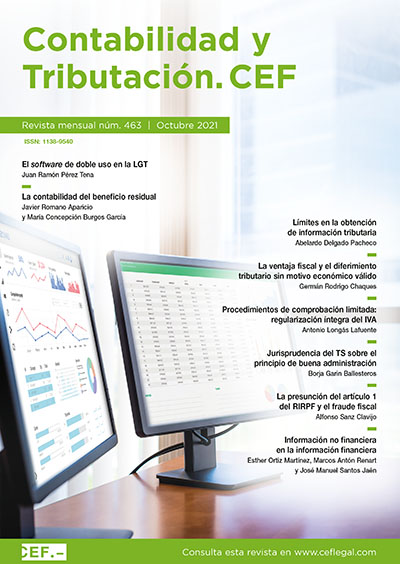La contabilidad del beneficio residual
DOI:
https://doi.org/10.51302/rcyt.2021.7443Palabras clave:
beneficio residual, precios de transferencia, contabilidadResumen
Este trabajo ha obtenido el 1.er Premio «Estudios Financieros» 2021 en la modalidad de Contabilidad.
En la tributación directa de la economía digital se ha impuesto la distribución del beneficio residual como fórmula para asignar a los países de mercado la base imponible generada sin establecimiento permanente. Es un proceso en dos pasos que primero distribuye los beneficios rutinarios a los países donde ocurren las actividades productivas utilizando los precios de transferencia, y después asigna los no rutinarios a los países donde se ubican los clientes o usuarios. Cuando esta propuesta cristalice en norma, los departamentos financieros de las multinacionales tendrán que distinguir a efectos fiscales entre beneficios rutinarios y beneficios residuales, algo que actualmente no hacen y para lo que necesitarán reorganizar sus sistemas de información financiera. La distribución del beneficio residual será parte del proceso de cumplimiento tributario, pero, igual que ocurre en el impuesto sobre sociedades actual, se basará en la información financiera de la empresa. De especial relevancia es la NIIF 8 –segmentos de operación– y más en general la contabilidad de costes. En este artículo examinamos el concepto «beneficio residual» y, a través de un caso práctico basado en las cuentas de la multinacional Apple, Inc., las implicaciones que tendrá para la gestión contable de las entidades multinacionales.
Descargas
Citas
Apple Inc. (2020). Condensed Consolidated Statements of Operations (unaudited). https://www.apple.com/newsroom/pdfs/FY20_Q4_Consolidated_Financial_Statements.pdf
Avi-Yonah, R.; Clausing, K. y Durst, M. (2009). Allocating Business Profits for Tax Purposes: A Proposal to Adopt a Formulary Profit Split. Florida Tax Review, 9, 497-553.
Beer, S; de Mooij, R.; Hebous, S.; Keen, M.; y Liu, L. (2020). Exploring Residual Profit Allocation. FMI Working Paper 20/49. https://www.imf.org/en/Publications/WP/Issues/2020/02/28/Exploring-Residual-Profit-Allocation-48998
Clavey, C.; Leigh-Pemberton, J.; Loeprick, J. y Verhoeven, M. (2019). International Tax Reform, Digitalization and Developing Economies. Discussion paper N 16. The World Bank. Octubre 2019. http://documents.worldbank.org/curated/en/735001569857911590/pdf/International-Tax-Reform-Digitalization-and-Developing-Economies.pdf
Delgado Terrón, M. (2020). El iPhone es utilizado por mil millones de usuarios en todo el mundo. https://www.pasionmovil.com/plataformas/apple/el-iphone-es-utilizado-por-mil-millones-de-usuarios-en-todo-el-mundo/#:~:text=El%20analista%20Neil%20Cybart%2C%20hizo,alcanzado%20el%20pico%20de%20ventas
Devereux, M. y Vella, J. (2018). Taxing the digitalised economy: targeted or system-wide reform. British Tax Review, 4, 301-320.
Devereux, M.; Auerbach, A.; Oosterhuis, P.; Schön, W. y Vella, J. (2019). Residual Profit Allocation by Income. Universidad de Oxford. https://eml.berkeley.edu/~auerbach/WP1901_0.pdf
FASB. (2021). Segment Reporting, Project Update. https://www.fasb.org/jsp/FASB/FASBContent_C/ProjectUpdateExpandPage&cid=1176170647220
IFRS US GAAP Comparison. (2019). https://www2.deloitte.com/content/dam/Deloitte/co/Documents/audit/Comparaci%C3%B3n%20IFRS%20US%20GAAP%202019.pdf
FMI. (2019). Tributación Internacional de Empresas. Documento de Política del FMI. Marzo de 2019. https://www.imf.org/~/media/Files/Publications/PP/2019/Spanish/PPSA2019007.ashx
G20 Information Centre. (2021). First Meeting of the G20 Finance Ministers and Central Bank Governors. Comunicado de prensa, 26 de febrero de 2021. First Meeting of the G20 Finance Ministers and Central Bank Governors, February 2021 (utoronto.ca)
HM Treasury. (2018). Corporate tax and the digital economy: position paper update. https://assets.publishing.service.gov.uk/government/uploads/system/uploads/attachment_data/file/689240/corporate_tax_and_the_digital_economy_update_web.pdf
IFRS. (2006). Norma Internacional de Información Financiera n.º 8, Segmentos de Operación. https://www.mef.gob.pe/contenidos/conta_publ/con_nor_co/no_oficializ/nor_internac/ES_GVT_IFRS08_2013.pdf
Li, J. (2002). Global Profit Split: An Evolutionary Approach to International Income Allocation. Canadian Tax Journal, 50, 823-883.
Marshall, A. (1890). Principles of Economics. https://eet.pixel-online.org/files/etranslation/original/Marshall,%20Principles%20of%20Economics.pdf
OCDE. (2013). Action Plan on Base Erosion and Profit Shifting. OECD Publishing. http://dx.doi.org/10.1787/9789264202719-en
OCDE. (2015). Addressing the Tax Challenges of the Digital Economy, Action 1 - 2015 Final Report. OECD/G20 Base Erosion and Profit Shifting Project. OECD Publishing. https://doi.org/10.1787/9789264241046-en
OCDE. (2017). OECD Transfer Pricing Guidelines for Multinational Enterprises and Tax Administrations 2017. OECD Publishing. https://doi.org/10.1787/tpG2017-en
OCDE. (2019). Secretariat Proposal for a «Unified Approach» under Pillar One. Public Consultation Document. https://www.oecd.org/tax/beps/public-consultation-document-secretariat-proposal-unified-approach-pillar-one.pdf
OCDE. (2020). Tax Challenges Arising from Digitalisation – Report on Pillar 1 Blueprint. https://doi.org/10.1787/beba0634-en
OCDE. (2021). Statement on a Two Pillar Solution to Address the Tax Challenges Arising From the Digitlisation of the Economy. https://www.oecd.org/tax/beps/statement-on-a-two-pillar-solution-to-address-the-tax-challenges-arising-from-the-digitalisation-of-the-economy-july-2021.pdf
Ohlson, J. A. (1995). Earnings, Book Values and Dividends in Equity Evaluation. Contemporary Accounting Research. https://onlinelibrary.wiley.com/doi/abs/10.1111/j.1911-3846.1995.tb00461.x
Schreiber, U. y Fell, L. M. (2017). International Profit Allocation, Intangibles, and Sales-Based Transactional Profit Split. World Tax Journal, 9, 1-18.
Statista. (2020). Establecimientos de la Firma Apple por el Mundo, 2005-2019. https://es.statista.com/estadisticas/552853/establecimientos-apple-a-nivel-mundial/
















